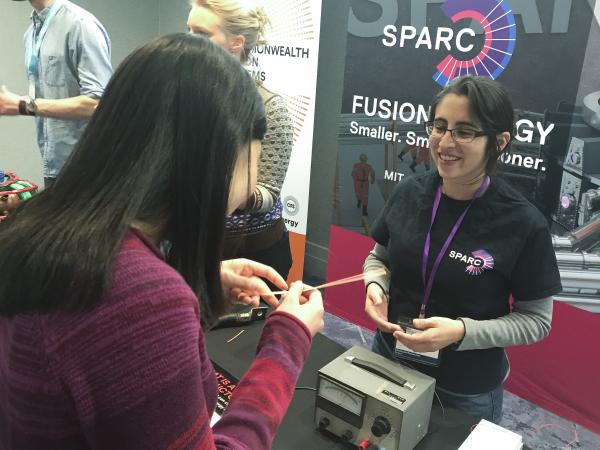
Graduate student Erica Salazar shows the thin superconducting tape that will replace bulky coils in the proposed SPARC tokamak.
Photo: Paul Rivenberg
PSFC and CFS team up to demonstrate the potential of fusion energy
April 16, 2019
On April 4 the Plasma Science and Fusion Center (PSFC) joined Commonwealth Fusion Systems (CFS) at the MIT Energy Conference Tech Showcase, to demonstrate the magnetic and plasma properties that underlie fusion technologies.
The conference annually presents an opportunity for leaders in industry, government and the scientific community, to engage in discussions about potential energy futures. Two days of talks are supplemented by the Tech Showcase, providing a chance for attendees to have one-on-one discussions with experts and energy visionaries, and to see hands-on demonstrations that illuminate the topics presented during the day.
The PSFC came to the Boston Marriott Cambridge in Kendall Square with a truckload of demonstrations that supported a keynote talk on “Paths to Commercial Fusion” by CFS CEO Bob Mumgaard (MIT ’15). Backed by posters of SPARC, the proposed PSFC tokamak experiment that projects a faster and more economical path to fusion, Alex Creely (MIT ’19) tended a plasma discharge tube. A visiting scientist working with CFS, Creely used a strong magnet to push and pull a glowing plasma, demonstrating how “the fourth state of matter” responds to magnetic fields, a property that makes it possible to contain hot fusion fuel for energy production.
Nearby, PSFC graduate student Libby Tolman provided a broad overview of fusion, from its role in the sun to its role in high-field tokamaks, answering a range of questions from interested participants. Other graduate students lined a table of demonstrations focusing on superconductivity. Erica Salazar showed off a key element of SPARC’s design - a thin superconducting tape that would replace the bulkier coils used in current tokamaks around the world, allowing a fusion device to be smaller and more economically constructed and operated. Theo Mouratidis and Caroline Sorensen demonstrated the effects of liquid nitrogen on high-temperature superconductors, while MIT sophomore Shiaoching (Ching) Tse, a CFS intern studying physics, raced a chilled puck around a circular track to demonstrate quantum levitation.
Graduate student Sean Ballinger used a hand-made model of a tokamak to point out the typical configuration of its magnets, while Patrick White and Evan Leppink used a large-screen interactive monitor to take viewers inside the machine and discussed how SPARC would compare to existing tokamaks.
Alex Creely, who as a PSFC graduate student participated in regular outreach activities, noted that the large number of people visiting the PSFC/CFS room seemed very excited about fusion, and about SPARC in particular.
“They recognized the need for on-demand, power-dense, carbon-free energy, and saw how fusion could fill that role.”
Topics: Magnetic fusion energy, Plasma science, Technology & engineering, SPARC, High field magnets, High-field pathway to fusion power